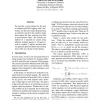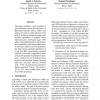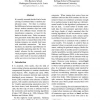ACL
2009
13 years 9 months ago
2009
Current SMT systems usually decode with single translation models and cannot benefit from the strengths of other models in decoding phase. We instead propose joint decoding, a met...
ACL
2009
13 years 9 months ago
2009
Correct stress placement is important in text-to-speech systems, in terms of both the overall accuracy and the naturalness of pronunciation. In this paper, we formulate stress ass...
ACL
2009
13 years 9 months ago
2009
We describe a novel method for the task of unsupervised POS tagging with a dictionary, one that uses integer programming to explicitly search for the smallest model that explains ...
ACL
2009
13 years 9 months ago
2009
We present a graph-based semi-supervised learning for the question-answering (QA) task for ranking candidate sentences. Using textual entailment analysis, we obtain entailment sco...
ACL
2009
13 years 9 months ago
2009
Supervised sequence-labeling systems in natural language processing often suffer from data sparsity because they use word types as features in their prediction tasks. Consequently...
ACL
2009
13 years 9 months ago
2009
This paper introduces a new algorithm to parse discourse within the framework of Rhetorical Structure Theory (RST). Our method is based on recent advances in the field of statisti...
ACL
2009
13 years 9 months ago
2009
Recent work on temporal relation identification has focused on three types of relations between events: temporal relations between an event and a time expression, between a pair o...
ACL
2009
13 years 9 months ago
2009
In this paper, we propose a novel method for semi-supervised learning of nonprojective log-linear dependency parsers using directly expressed linguistic prior knowledge (e.g. a no...
ACL
2009
13 years 9 months ago
2009
Cross-lingual tasks are especially difficult due to the compounding effect of errors in language processing and errors in machine translation (MT). In this paper, we present an er...
ACL
2009
13 years 9 months ago
2009
It is usually assumed that the kind of noise existing in annotated data is random classification noise. Yet there is evidence that differences between annotators are not always ra...



